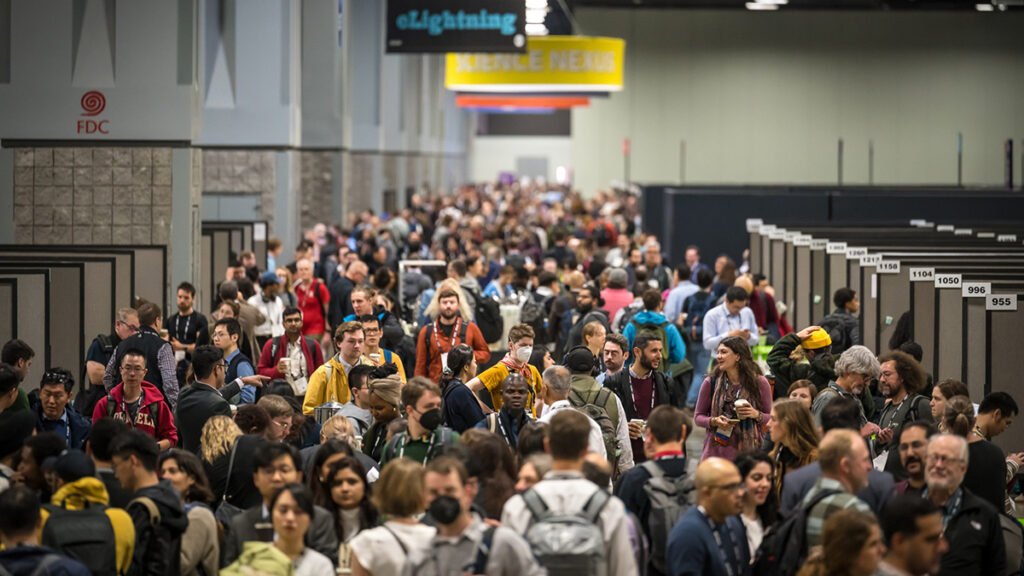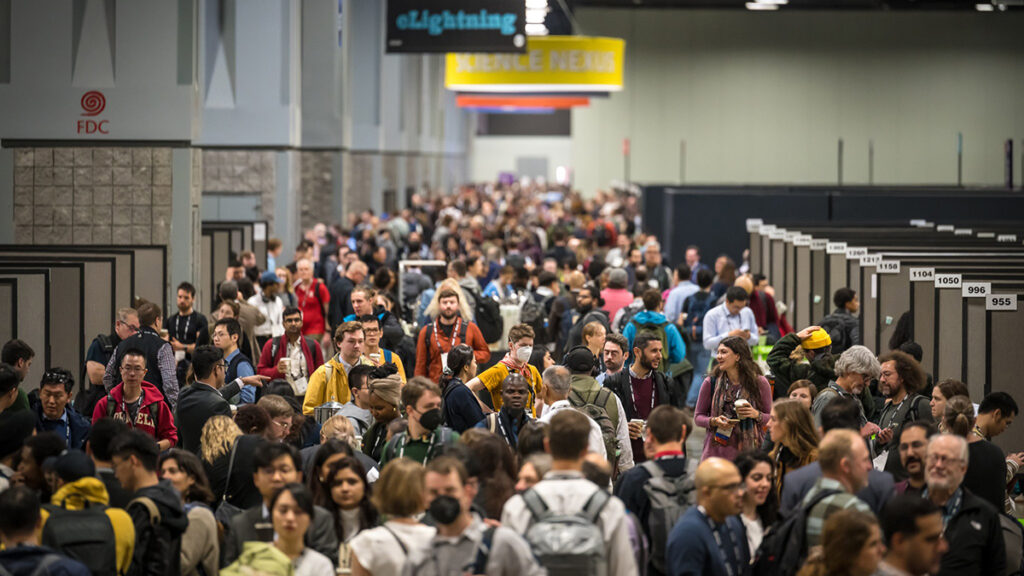

Conferences are key enablers of community building within and outside academic ecosystems, bringing together broad groups of individuals with different perspectives, experiences, and backgrounds. They can also provide safe and constructive environments for open discussions of cultural issues important to scientific communities, including those related to equality, diversity, and inclusion (EDI, also known as DEI) [Hauss, 2021; Zierath, 2016].
These discussions, which likely would not otherwise occur on a broad scale outside of meetings [Oester et al., 2017; Barrows et al., 2021], are particularly valuable in geoscience and climate research. Those fields are notably lacking in diversity, and within them, hearing the voices of marginalized groups is crucial for guiding effective evidence-informed public policy [Standring and Lidskog, 2021; Bernard and Cooperdock, 2018; Colquhoun and Fernando, 2020; Dowey et al., 2021]. Involvement in conference EDI programming by a wide swath of the scientific community can also help to ameliorate the academic “minority tax” that often disproportionately burdens scientists from underrepresented groups with the responsibility for driving change.
Many conferences now include EDI-related sessions [e.g., Fiedler and Brittani, 2021]. However, encouraging broad engagement with EDI- and community culture–focused sessions—both those looking inward within academia and those looking outward at how science affects society—at conferences remains a challenge. On the basis of our experiences organizing these types of sessions and the current literature on best practices, we propose eight changes that organizers and convenors can implement to boost attendance in, engagement with, and useful outputs from such discussions. These approaches group into three themes: focusing attention on EDI programming, facilitating open and productive discussion, and emphasizing evidence and solutions.
Focusing Attention on EDI Programming
A key part of generating wider engagement with equality, diversity, and inclusion (EDI) sessions at conferences is indicating that they are priorities for organizers and all attendees.
1. Be thoughtful about time-tabling. A key part of generating wider engagement with EDI sessions is indicating that they are priorities for organizers and all attendees (especially those in leadership roles), rather than ancillary topics of interest only to marginalized groups. Meeting convenors can signal this importance through effective time-tabling of EDI sessions, which can enhance attendance and engagement [Burnett et al., 2020].
Specifically, we advise against holding these sessions at the start or end of the day, when attendance tends to be lowest, especially for those with caregiving responsibilities. Likewise, organizers should be cognizant of how placing these sessions at the very end of conference programs may result in sparse attendance, unintentionally portray the session topics as less valuable to the community, and reduce their effectiveness in influencing change. Instead, we suggest that convenors schedule EDI-related sessions during the main program alongside prominent scientific programming and use plenary and keynote talks to highlight and support discussions of EDI.
2. Optimize physical placements. In addition to careful time-tabling of EDI sessions, organizers should consider how to maximize attendees’ opportunities to engage with related posters and talks by designating optimal locations for content sharing. EDI-related issues have an advantage over many scientific topics in that they are relevant to all attendees; hence, placing them in central, easily accessible locations where they are more visible can spur additional attention and discussion. Additional suggestions for placing EDI posters include displaying them outside main poster halls (e.g., in reception areas), allowing them to be presented multiple times (e.g., once in an “EDI” session and once in a “science” session), and fully integrating them into scientific poster sessions to help normalize conversations around culture in science.
Facilitating Open and Productive Discussion
3. Create welcoming and respectful spaces. Considering how personal issues related to EDI can be, it is crucial that conferences establish robust and agreed-upon codes of conduct and norms for related discussions, as well as mechanisms to enforce them if needed [e.g., Favaro et al., 2016]. Such frameworks help to ensure that conferences are spaces where attendees can present their ideas freely while being accountable for their contributions. The code of conduct and norms should also make clear that reasonable and respectful challenges of ideas (and recognition of how the conduct of these discussions affects others) are encouraged when discussing issues of community culture, in the same way they are in discussions of scientific ideas. Common terminologies for use within EDI discussions can also help to overcome differences in the meanings of words or concepts among countries and languages [Fernando et al., 2024], which can be especially important at climate and geoscience research conferences, given their international attendance.
Many conferences group all EDI-related contributions into large catchall sessions, which can make it challenging for attendees to identify best practices relating to specific aspects of EDI.
4. Avoid additional costs for attendees. Many conferences limit attendees to giving a single oral presentation, which can force them to choose between presenting their science (which often is more highly rewarded in academic systems) or their EDI-related work or experiences. Best practice has been showcased by some organizations, such as AGU, which now allows presenters to contribute two abstracts to its Annual Meeting. Nonetheless, the costs of submitting an additional abstract to a conference can impose a significant financial constraint on a researcher, especially if they must pay for poster printing in cases where only one oral contribution is permitted. When reviewing EDI- and community-focused abstracts, organizers should consider dispensing with single oral abstract submission rules, issuing fee waivers for these abstracts, or issuing small rebates in registration fees (e.g., $50) to partially cover poster printing costs.
5. Group EDI contributions by topic. EDI encompasses a wide range of specific subtopics, from school education to inclusion in graduate programs and beyond. However, many conferences group all EDI-related contributions into large catchall sessions, which can make it challenging for attendees to identify best practices relating to specific aspects of EDI. Organizers should solicit enough EDI contributions that they can group them by theme. Especially at larger conferences, having themes will help organizers reach the critical mass of posters and talks needed to hold parallel sessions focusing on different issues (e.g., one about geoscience education in schools and another about accessible fieldwork), hence maximizing the potential for useful discussions. The United Kingdom’s Royal Astronomical Society, for example, has demonstrated best practice in its larger meetings by soliciting contributions to specifically organized EDI sessions that are integrated into the main conference program but have different focuses (e.g., outreach, supporting students and postdocs).
Emphasizing Evidence and Solutions
6. Encourage sharing of data and applicable lessons. A major benefit of conferences is the opportunities they offer to develop new ideas in groups and to identify and optimize existing solutions that can be applied in new settings. Science departments and institutions often run dedicated programs to widen participation, increase diversity, and improve inclusivity, many of which include elements for monitoring and evaluating their success. However, these programs—and the qualitative and quantitative data they produce—are rarely discussed or presented in conference settings, limiting chances for shared identification of lessons learned and where else such lessons can be applied.
To call attention to the scientific basis behind effective EDI interventions, organizers should explicitly encourage contributions that showcase institutional programs and their evaluations. This encouragement might include asking presenters to share data reflecting how their intervention had positive outcomes or, conversely, why it was ineffective (and what lessons can be learned as a result). Organizers could also provide guidelines for how to present EDI work and outreach programs such that intervention successes and best practices can be shared clearly and potentially scaled for use in other institutions (e.g., by explicitly addressing issues of funding, time and added labor costs, and other logistical requirements). Furthermore, organizers should consider optimal formats for engagement around this information. Standard lecture-style talks, for example, may be less effective than town halls, open discussions, or breakout working groups.
Making an effective case for the need for broad interventions often requires providing quantitative evidence linking individual experiences to systemic and problematic issues.
7. Encourage presenters to link experience and evidence. Issues relating to EDI, scientific culture, and the academic community are naturally rooted in individuals’ lived experiences, and hence, presentations on these experiences often form a substantial portion of EDI sessions. As powerful as these presentations typically are, making an effective case for the need for broad interventions to scientists and decisionmakers (e.g., funding bodies) often requires providing quantitative evidence linking individual experiences to systemic and problematic issues.
Encouraging presenters in EDI sessions to frame their discussions in a scientific light when possible—for example, by presenting a clear synthesis of background literature and an evidence base for the work—can help foster positive reactions and productive decisionmaking for implementing change. Professional associations and conference hosts could, again, provide presenters with best-practice guidelines for discussing EDI topics (for example, encouraging the use of quantitative evaluation and significance testing), given that many EDI presenters are not social scientists by training.
8. Provide space and funding for additional community events. Society and conference leadership should also support their community members and attendees in organizing affiliated EDI-related events that do not fall within traditional conference programs of talks and posters. This support could include providing space or other accommodations (e.g., free refreshments) for groups to arrange meetups or social events that encourage community building and a sense of belonging. Or it could entail offering groups the opportunity to add their events to the main conference program, rather than organizing them on the periphery. When possible, support should also be offered for these groups to write and publish summaries of observations and outcomes from their EDI-related sessions—for example, through small grants funding the publication of white papers—to extend the reach and impact of their discussions.
Progressing Toward Greater Engagement
Enacting many of the above suggestions will come with financial, logistical, or workload costs for conference organizers. Waiving or reducing abstract fees for EDI-related abstracts, for example, would reduce revenue and must be balanced against other financial constraints and commitments, such as providing financial support to people who would otherwise be unable to attend.
These suggestions for change need not all be acted upon simultaneously. Gradual change, such as tackling the simplest improvements first, still represents progress.
Nonetheless, some suggestions (e.g., optimizing scheduling and physical placement of sessions and soliciting more EDI-related abstracts) should incur little to no additional financial cost and could be acted upon immediately. Others, such as developing guidelines for effective presentation of EDI talks and posters, will likely require more sustained effort over multiple conference cycles. Outside experts in EDI, for example, from the diversity committees of professional societies, may be able to help here.
Ideally, conference organizers would adopt all the outlined approaches—and perhaps find additional ways to spotlight and support EDI research and discussions at their events. Considering the many challenges and constraints of conference planning, though, it is important to note that these suggestions for change need not all be acted upon simultaneously. Gradual change, such as tackling the simplest improvements first, still represents progress and should encourage broader engagement in EDI sessions and conversations at scientific conferences. This engagement is especially vital in geoscience and climate science, where research often has inherent and significant implications for communities and, hence, where the presence of diverse voices is key to producing effective change.
Acknowledgments
We are grateful to Emily Ward and Becca Edwards for their helpful suggestions in compiling this article.
References
Barrows, A. S., M. A. Sukhai, and I. R. Coe (2021), So, you want to host an inclusive and accessible conference?, FACETS, 6(1), 131–138, https://doi.org/10.1139/facets-2020-0017.
Bernard, R. E., and E. H. Cooperdock (2018), No progress on diversity in 40 years, Nat. Geosci., 11(5), 292–295, https://doi.org/10.1038/s41561-018-0116-6.
Burnett, N. P., et al. (2020), Conference scheduling undermines diversity efforts, Nat. Ecol. Evol., 4, 1,283–1,284, https://doi.org/10.1038/s41559-020-1276-5.
Colquhoun, R., and B. Fernando (2020), An audit for action, Astron. Geophys., 61(5), 5.40–5.42, https://doi.org/10.1093/astrogeo/ataa075.
Dowey, N., et al. (2021), A UK perspective on tackling the geoscience racial diversity crisis in the Global North, Nat. Geosci., 14(5), 256–259, https://doi.org/10.1038/s41561-021-00737-w.
Favaro, B., et al. (2016), Your science conference should have a code of conduct, Front. Mar. Sci., 3, 103, https://doi.org/10.3389/fmars.2016.00103.
Fernando, B., et al. (2024), Evaluation of the InSightSeers and DART Boarders mission observer programmes, Nat. Astron., 8, 1,521–1,528, https://doi.org/10.1038/s41550-024-02434-1.
Fiedler, B. P., and S. Brittani (2021), Conference critique: An analysis of equity, diversity, and inclusion programming, paper presented at 2021 ALA Virtual Annual Conference, Assoc. of Coll. and Res. Libr.
Hauss, K. (2021), What are the social and scientific benefits of participating at academic conferences? Insights from a survey among doctoral students and postdocs in Germany, Res. Eval., 30(1), 1–12, https://doi.org/10.1093/reseval/rvaa018.
Oester, S., et al. (2017), Why conferences matter—An illustration from the International Marine Conservation Congress, Front. Mar. Sci., 4, 257, https://doi.org/10.3389/fmars.2017.00257.
Standring, A., and R. Lidskog (2021), (How) does diversity still matter for the IPCC? Instrumental, substantive and co-productive logics of diversity in global environmental assessments, Climate, 9(6), 99, https://doi.org/10.3390/cli9060099.
Zierath, J. R. (2016), Building bridges through scientific conferences, Cell, 167(5), 1,155–1,158, https://doi.org/10.1016/j.cell.2016.11.006.
Author Information
Benjamin Fernando (bfernan9@jh.edu), Department of Earth and Planetary Sciences, Johns Hopkins University, Baltimore, Md.; and Mariama Dryák-Vallies, Center for Education, Engagement and Evaluation, Cooperative Institute for Research in Environmental Sciences, University of Colorado Boulder
Citation: Fernando, B., and M. Dryák-Vallies (2025), Eight ways to encourage equality, diversity, and inclusion discussions at conferences, Eos, 106, https://doi.org/10.1029/2025EO250291. Published on 5 August 2025.
This article does not represent the opinion of AGU, Eos, or any of its affiliates. It is solely the opinion of the author(s).
Text © 2025. The authors. CC BY-NC-ND 3.0
Except where otherwise noted, images are subject to copyright. Any reuse without express permission from the copyright owner is prohibited.


